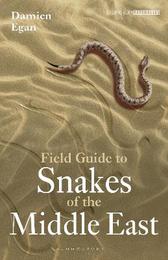
|
Field Guide to Snakes of the Middle East
Paperback / softback
Main Details
| Title |
Field Guide to Snakes of the Middle East
|
| Authors and Contributors |
By (author) Damien Egan
|
| Series | Bloomsbury Naturalist |
|---|
| Physical Properties |
| Format:Paperback / softback | | Pages:240 |
|
| Category/Genre | Reptiles
Pets and the Natural World |
|---|
| ISBN/Barcode |
9781472987327
|
| Classifications | Dewey:597.960956 |
|---|
| Audience | |
|---|
| Illustrations |
Colour plates of every species in the region
|
|
Publishing Details |
| Publisher |
Bloomsbury Publishing PLC
|
| Imprint |
Bloomsbury Wildlife
|
| Publication Date |
21 July 2022 |
| Publication Country |
United Kingdom
|
Description
Arabia and the Middle East have an unusually rich herpetofauna, and this is exemplified by the region's snakes. There are almost 190 species, and this new field guide offers a way to identify them. Written by expert Damien Egan and illustrated with his brilliant digital imagery, the book consists of 87 plates, each containing two or three species, with the snakes illustrated along with comparison species and diagnostic features in detail, such as head and keel scales. A concise species text accompanies each plate, highlighting ID, ecology, habitat and prey, along with notes on venom. Introductory text covers the snakes of the region more widely, with a discussion on how and where to find them and how to study them safely. Ambitious in scope, this book will be of great interest to all herpetophiles living in or visiting this broad and diverse region.
Author Biography
Damien Egan started working professionally with reptiles in 1994 in South Africa, and became curator of two prominent reptile centres there before moving to the Middle East at the beginning of 2000. During his time in the Middle East, he headed up various captive breeding conservation programmes, resulting in the first captive breeding of numerous species of rare reptiles, amphibians and freshwater fishes. Damien has travelled to a great many remote areas throughout the region, doing baseline surveys, rapid assessment surveys, environmental impact assessments and specimen collection, as well as giving talks and lectures on reptiles, snake bites and related subjects.
|